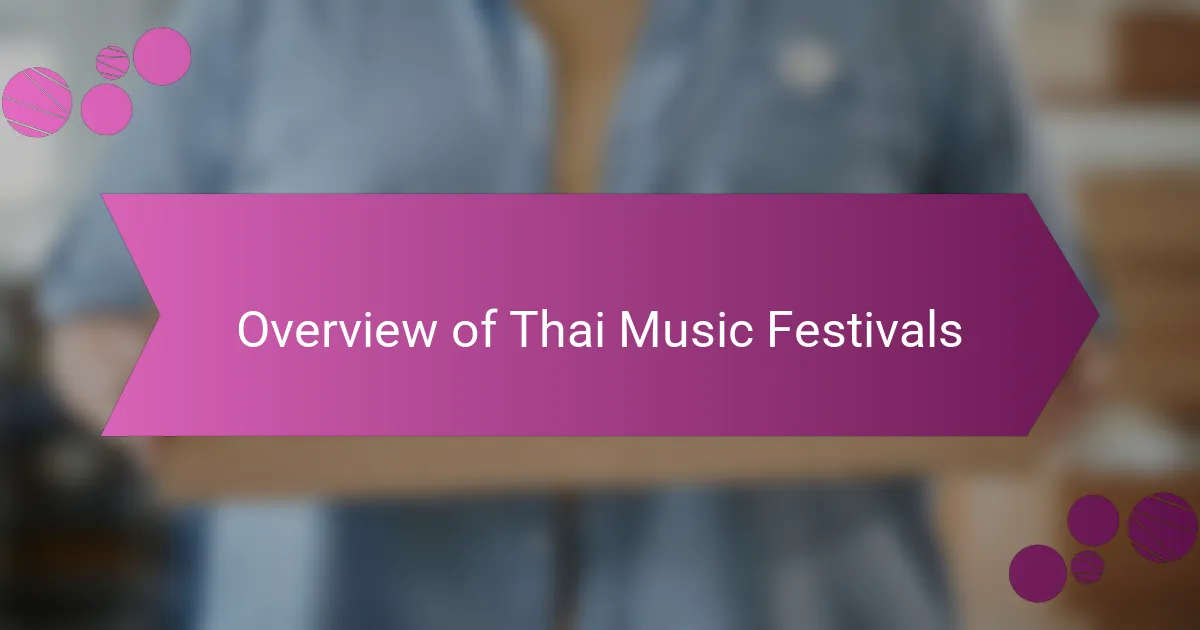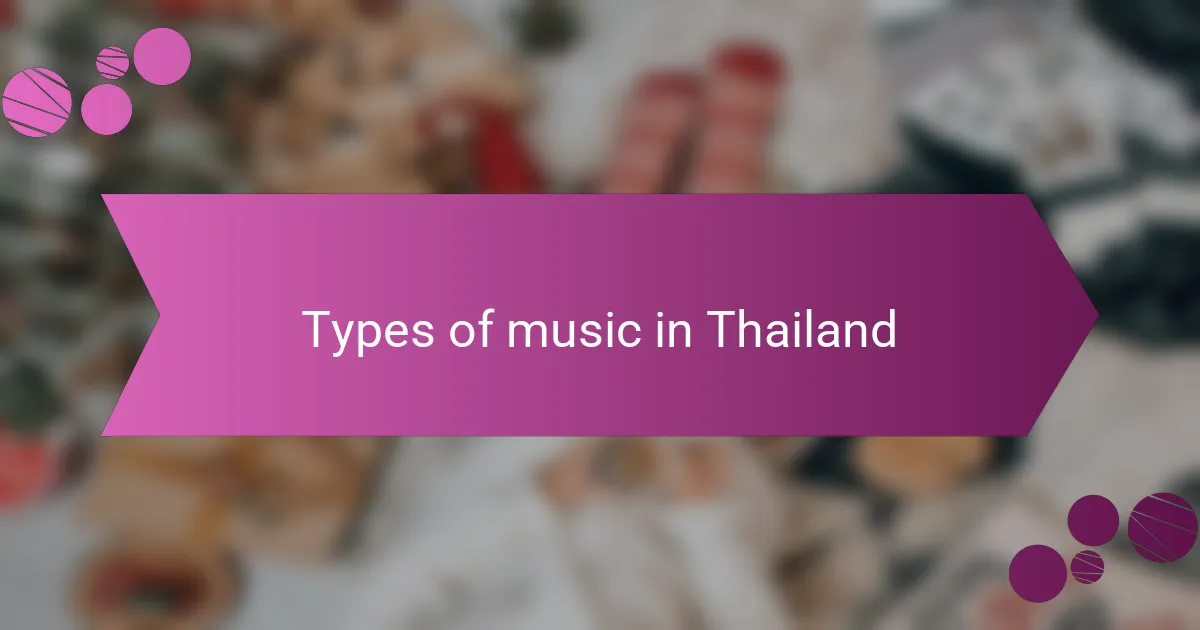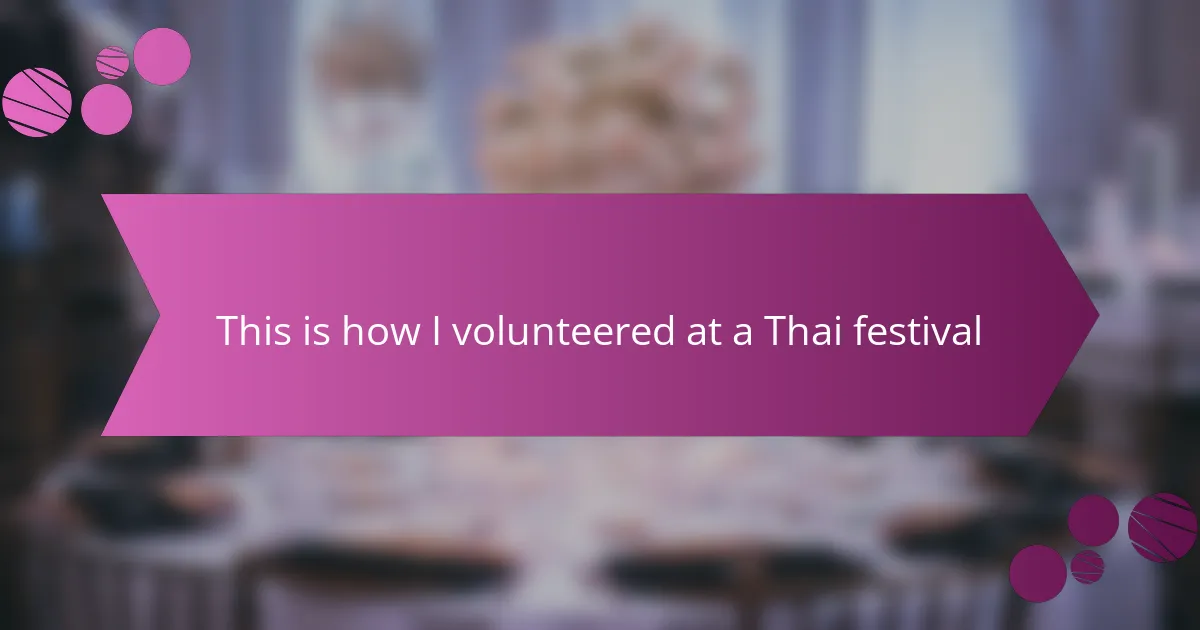Key takeaways
- Thai music festivals celebrate the country’s rich musical heritage, blending traditional and contemporary styles.
- Traditional Thai music utilizes unique instruments like the ranat and khim, reflecting historical and cultural narratives.
- Preparation for a concert involves understanding music styles, attire, and essentials to enhance the experience.
- Live performances, such as khon dance and traditional orchestras, create a profound connection among audiences through shared cultural appreciation.

Overview of Thai music festivals
Thai music festivals are a vibrant celebration of culture and art, showcasing the rich musical heritage of Thailand. Attending these festivals, I’ve often felt a unique energy in the air, one that connects people from all walks of life through the shared love of music. Isn’t it fascinating how sound can bridge gaps and create moments of joy?
One of my favorite experiences was at a traditional Thai music festival where I witnessed live performances of Thai classical music alongside contemporary fusion bands. The variety of sounds was astounding; it underscored the evolution of Thai music while honoring its roots. How often do we get the chance to observe such a beautiful blend of old and new in one place?
These festivals also serve as a gathering point for diverse communities, offering everything from food stalls that tantalize the senses to art and craft markets. I remember walking through the festival grounds, being captivated by the lively atmosphere and the smiles of strangers turned friends. Don’t you think it’s remarkable how music can create connections that last a lifetime?

History of Thai music
Thai music has a rich history that intertwines with the country’s culture and heritage. Over centuries, traditional Thai music has evolved, combining influences from indigenous sounds and neighboring regions. I remember sitting in my first traditional Thai concert, feeling the deep connection to history as the musicians brought ancient melodies to life.
The traditional instruments, such as the ranat (a type of xylophone) and the khim (a hammered dulcimer), carry stories from various Thai epochs. Each note seemed to echo the past, and it was thrilling to witness such artistry in person. It truly felt like stepping into a musical time machine, bringing the essence of Thailand’s history right before my eyes.
In contemporary times, while modern influences have begun to reshape Thai music, the roots remain strong. I find it fascinating how traditional elements persist and evolve even in today’s diverse music scene.
| Era | Characteristics |
|---|---|
| Ancient Period | Use of indigenous instruments, vocal traditions reflecting religious and royal themes. |
| Classical Period | Development of court music, incorporation of dance and drama. |
| Modern Era | Fusion with Western styles, emergence of contemporary genres, yet honoring traditional roots. |

Types of music in Thailand
There’s a delightful tapestry of music types in Thailand that always amazes me. Traditional Thai music, for instance, is heavily characterized by various instruments like the ranat and the pi, which create delicate yet intricate melodies. When I first heard the haunting sounds of the pi during a concert, it resonated deep within me, transporting me to a serene landscape filled with vibrant colors and rich history. What a beautiful way to experience culture!
In contrast, contemporary Thai music embraces a fusion of styles, blending pop, rock, and even hip-hop with traditional elements. I was surprised to find that some of my favorite pop songs include traditional rhythms and instruments. It made me realize how versatile Thai music truly is. Have you noticed how blending genres can create something entirely new yet familiar?
Even regional variants of music play an essential role in the local culture, with styles like Isan folk music from the northeast and Southern Thai music showcasing distinct flavors. Attending festivals has allowed me to appreciate these differences firsthand. Each region tells its own story through music, and it’s a beautiful reminder of the diversity within Thailand itself. Don’t you think that this variety enriches the overall experience of Thai music?

Preparation for a Thai concert
Preparing for a traditional Thai concert is an experience in itself. I remember the excitement bubbling inside me as I gathered my essentials—comfortable clothing, a water bottle, and my camera for capturing memories. The vibrant atmosphere often starts long before the music begins, setting the stage for an unforgettable evening.
It’s also important to familiarize yourself with traditional Thai music styles. Knowing a bit about the sounds and instruments can enhance your enjoyment. I spent some time listening to various genres, which made it easier to connect with the performances during the concert.
Here’s a quick comparison table to highlight what to consider when preparing for a Thai concert:
| Preparation Aspect | My Experience |
|---|---|
| Attire | Light, breathable clothing is essential for comfort. |
| Knowledge of Music | Familiarity with styles deepens appreciation. |
| Essentials to Bring | Water, camera, and a spirit of adventure! |

Personal experience at the concert
While attending the traditional Thai concert, I was immediately struck by the vibrant colors and the lively ambiance of the space. As the musicians took their positions, I felt the collective excitement swirling around me, palpable enough to touch. It was as if we were all drawn together by an invisible thread, ready to embark on a musical journey that celebrated our shared heritage.
The first notes from the ranat filled the air, and I was transported. I remember closing my eyes, letting the melodies wash over me. Each sound seemed to resonate with a part of my soul, reminding me of the depth and beauty of Thailand’s culture. Have you ever felt so deeply connected to a piece of music that it transcends your surroundings? That was my moment—a profound realization that music can encapsulate emotions and histories in ways that words sometimes cannot.
As the concert unfolded, I was fascinated by the blend of traditional and modern styles, showcasing the evolution of Thai music. I couldn’t help but smile as I saw older generations swaying alongside younger audience members, united by the infectious rhythms. It made me wonder, how many stories were we sharing through our dance and laughter? There, in that special gathering, I felt a genuine sense of community built on our love for the art and the culture that nourishes it.

Favorite performances at the festival
One of my favorite performances at the festival was a captivating display of traditional khon dance. The dancers, dressed in glimmering costumes, brought ancient stories to life with their grace and precision. Watching them, I felt an overwhelming sense of pride in Thailand’s rich cultural heritage.
Another highlight was the live traditional Thai orchestra, which enveloped the audience in the soothing sounds of the ranat (a type of xylophone) and the pi java (a traditional flute). I remember closing my eyes and letting the music transport me to another time, where each note resonated deeply within me.
Every performance had its unique charm, but what struck me the most was how the artists poured their hearts into each act. Their passion was infectious, making it impossible not to smile and feel a connection to my roots.
| Performance | Highlight |
|---|---|
| Khon Dance | Dancers brought ancient stories to life with grace and precision. |
| Traditional Thai Orchestra | Enveloped the audience in soothing, melodic sounds. |



